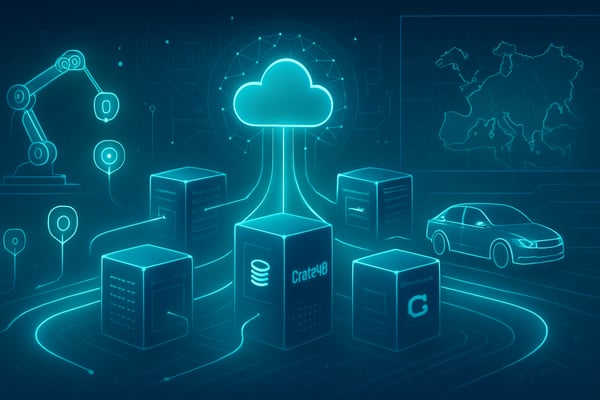Via their partnership, Coreflux and CrateDB offer a powerful solution for Industrial IoT (IIoT) and real-time data processing. Coreflux is an IoT data management platform offering end-to-end industrial IoT solutions, including connectivity, data processing, and integration with cloud and edge computing environments. It acts as a bridge between industrial devices, protocols, and cloud platforms, while CrateDB provides scalable, high-performance time-series data storage and analytics.
This combination enables industries to efficiently collect, store, and analyze massive volumes of machine-generated data, empowering organizations with real-time decision-making capabilities and predictive insights.
Architecture diagram

Benefits of Integrating CrateDB with Coreflux
- Scalable Data Ingestion – Handle high-velocity industrial data streams from thousands of IoT devices.
- Seamless Interoperability – Connect heterogeneous industrial protocols (MQTT, OPC UA, Modbus) directly to CrateDB.
- Real-Time Querying – Gain instant insights into operational data with CrateDB’s time-series querying.
- Edge & Cloud Flexibility – Deploy at the edge for real-time control or in the cloud for large-scale analysis.
- High Availability – Ensure continuous data flow and redundancy for mission-critical applications.
- Security & Data Ownership – Maintain complete control over industrial data with Coreflux’s modular architecture.
Example Use Case: Smart Manufacturing
In a smart factory, thousands of sensors and machines generate continuous streams of temperature, vibration, pressure, and operational status data. Coreflux ingests this data, while CrateDB stores and analyzes it to:
-
Detect anomalies in production lines in real time.
-
Predict machine failures before they happen.
-
Optimize energy consumption and reduce operational costs.
-
Enable AI-driven automation for process efficiency.
This results in faster decision-making, reduced downtime, and increased production efficiency.
How it Works
Coreflux acts as an industrial connectivity layer, ingesting data from shop-floor machines, sensors, and PLCs using industrial protocols such as OPC UA, MQTT, and Modbus. The collected data is then transformed and sent to CrateDB, which provides fast and efficient storage, querying, and analytics.
- Industrial Equipment & Sensors → Data is collected via Coreflux’s protocol connectors (MQTT, OPC UA, Modbus, PostgreSQL, etc.).
- Coreflux Edge & Cloud → Processes and normalizes incoming machine data in real time.
- CrateDB → Stores, indexes, and analyzes time-series and relational data at scale.
- Dashboards & Applications → Visualize real-time data with Grafana, Power BI, or custom apps.
Key Advantage: Coreflux enables unified industrial data collection and processing, while CrateDB ensures optimal performance for time-series analytics, predictive maintenance, and AI-driven automation.
Conclusion
The CrateDB + Coreflux integration is ideal for industries looking to unlock real-time insights from vast amounts of IoT and industrial data. By combining Coreflux’s modular connectivity with CrateDB’s scalable real-time analytics engine, organizations can achieve:
- Faster time to insights
- Optimized industrial processes
- Predictive maintenance & automation
- Full data ownership & security
Get Started Today!
> Learn more about Coreflux
> Learn more about CrateDB


